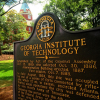news
Happy Birthday, Georgia Tech
Primary tabs
On Oct. 13, 1885, the Georgia School of Technology was founded as part of a plan to help transform the agrarian South into an industrial economy. The university officially opened three years later after the construction of Tech Tower and a shop building. It enrolled 84 students and offered only one degree — in mechanical engineering.
Marilyn Somers, director of Georgia Tech’s Living History Program, said she is amazed at how rigorous Georgia Tech was — even in the early days.
“It is clear that from its very beginning, the intention was to set the bar high academically,” said Somers. “Based on the evidence of retention, they met the goal, as only one out of five students who were accepted, were still in school three months later.”
That level of rigor has, no doubt, contributed to Georgia Tech’s transformation into a science and technology powerhouse. This year, for the 16th consecutive year, U.S. News & World Report has ranked Tech one of the top 10 public universities. It also has Tech listed at No. 7 among public universities and 35th among all national universities.
Milestones in Tech History
1885 – On Oct. 13, the Georgia Legislature passed a bill appropriating $65,000 to found a technical school.
1888 – The Academic Building, known today as the Lettie Pate Whitehead Evans Administration Building or Tech Tower, was completed. Enrollment began with 84 students.
1893 – Tech played its first football game against the University of Georgia, winning 28-6, making it the school’s very first victory.
1905 – Tech adopted Ramblin’ Wreck as the official fight song, although it had been the unofficial fight song for several years.
1911 – The first issue of the student newspaper, The Technique, was published on Nov. 17.
1917 – Women were allowed to attend Georgia Tech — but only through its Evening School of Commerce. After the School was removed in 1931, women were unable to enroll at Tech — with the exception of the WWII years when they were permitted to attend but not earn degrees. It would be 1952 before they could do so.
1928 – Former student Frank Gordy opened a restaurant called The Yellow Jacket near campus. The name soon changed to The Varsity.
1934 – To boost the state’s economy in the midst of the Great Depression, the Engineering Experiment Station, now known as the Georgia Tech Research Institute, was founded as the nonprofit applied research arm of Georgia Tech.
1948 – The university’s name was changed to the Georgia Institute of Technology, reflecting an increasing focus on technological and scientific research.
1952 – Women were permitted to enroll only in Georgia Tech degree programs not offered at other universities in Georgia.
1961 – Tech became the first university in the Deep South to admit African-American students without a court order. Ford Greene, Ralph A. Long Jr., and Lawrence Michael Williams were Tech’s first three African-American students.
1965 – Ronald Yancey, the first African-American student to graduate from Tech, earned a B.S. in electrical engineering.
1968 – Helen E. Grenga, a chemical engineer, became Georgia Tech’s first full-tenured female engineering professor.
1970 – The Board of Regents voted to allow women to enroll in all programs at Tech, superseding the 1952 policy.
1985 – Tech President Joseph E. Pettit and J. Erskine Love Jr. spearheaded the Institute’s $100 million Centennial Campaign, raising a total of $202.7 million.
1990 – Georgia Tech-Lorraine opened in Metz, France. Its primary focus is graduate education, sponsored research, and an undergraduate summer program.
1996 – Georgia Tech was the Home of the Olympic Village for the Summer Olympic Games. A substantial amount of construction occurred, including the erection of housing, the Georgia Tech Aquatic Center, and the renovation of the Alexander Memorial Coliseum.
2003 – Technology Square, the heart of the Institute’s internationally recognized innovation ecosystem, opened its doors.
2013 – Tech introduced the first accredited Master of Science in Computer Science degree that students can earn exclusively through the massive open online course (MOOC) delivery format — for a fraction of the cost of on-campus programs.
2015 – The freshman class is record-setting in its diversity and academic prestige. It is 41 percent female and has 35 percent more African-American students than 2014. The academic profile, which includes SAT scores and number of college-level classes taken, is the best it has ever been.
Groups
Status
- Workflow status: Published
- Created by: Kristen Bailey
- Created: 10/13/2015
- Modified By: Fletcher Moore
- Modified: 10/07/2016
Categories
Keywords


